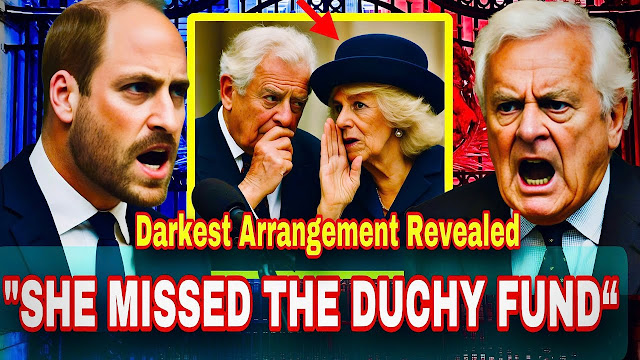Ads
The tipping point was the unexpected release of a private audio recording—an intimate memoir-style interview in which Andrew Parker Bowles discusses the unraveling of his marriage to Camilla and the shadowy financial dealings that allegedly supported her rise from aristocratic obscurity to Queen Consort. What was originally intended as a personal keepsake for his children became public, quickly going viral and creating an earthquake within royal circles.
The interview outlines a complex web of alleged financial manipulation, personal betrayal, and long-term ambition that saw Camilla gradually gain influence over Prince Charles—now King Charles III—and, by extension, the Crown itself. According to Parker Bowles, Camilla began building this network of influence in the late 1980s, using offshore trusts, shell corporations, and cleverly disguised charitable foundations to exert control and mask financial activities. Once this story leaked, Prince William was faced with a brutal decision: preserve public trust by acting decisively, or protect family unity by keeping the issue private.
Ads
Ultimately, William chose transparency. He convened his top advisors at Kensington Palace, and by dawn the next morning, a formal message was dispatched to Buckingham Palace: the royal household would cease all financial support to Camilla’s extended family. Though the move appeared sudden, those close to William suggest it was driven by deep personal conviction rather than optics. The Prince of Wales reportedly drew a line between the monarchy he envisions for the future and the compromises of the past.
Andrew Parker Bowles, now in his eighties, claims he never sought to be in the limelight again but felt compelled to set the record straight. The marriage between him and Camilla was long seen as a union of equals—Camilla, with her laid-back charm, captivated aristocratic rebels, while Andrew, a decorated cavalry officer, was a favorite of the Queen Mother. But their relationship began unraveling when Camilla rekindled her connection with Prince Charles in the early 1980s, shortly before Charles’s ill-fated marriage to Princess Diana.
Ads
According to Parker Bowles, even after their divorce in 1995, Camilla remained a central figure in Charles’s life. He claims she advised Charles on financial matters during the most vulnerable period of his public life—just after his separation from Diana—and helped shift assets into less scrutinized channels. Allegedly, between 1988 and 1992, Camilla created multiple trusts overseas, some designed to manage estate repairs or reroute rental income in a way that escaped public accounting. These claims are partially supported by past financial leaks.
Following the release of the interview, Prince William, alongside Princess Catherine—despite her ongoing health challenges—reviewed detailed reports about financial disbursements to Camilla’s relatives. Nearly £5 million per year had been flowing quietly to her family for various reasons, including property upkeep and charitable advisory roles. While not illegal, the optics were troubling. William, after days of deliberation, issued the order to end all such payments. Sources say Charles received the news in silence, while Camilla, deeply upset, left the room in tears.
Ads
The press erupted. Headlines screamed of royal betrayal, and hashtags like #CrownControl and #CamillaGate trended across social platforms. Polls showed public support tilting toward William. His move was described as morally driven—a purification effort meant to rid the monarchy of questionable entanglements.
Historians drew parallels to past royal crises, from the abdication of Edward VIII to the scandalous Profumo affair. But in today’s age of streaming platforms and online investigations, the implications were more far-reaching. Some Republican MPs began calling for transparency, and international reactions followed. In Canada, lawmakers debated removing the monarchy from national currency. Australian and Caribbean commentators saw the drama as evidence of the Crown’s obsolescence in modern times.
Camilla, via her legal team, insisted that any financial arrangements were legitimate and advised by professionals. Friends say she remains stoic, having weathered decades of scrutiny. But pressure continues to mount. Royal lawyers are preparing for possible lawsuits from Camilla’s relatives, some of whom may now be at financial risk due to the severed support. At the same time, pro-monarchy and anti-monarchy protesters have taken to the streets outside Buckingham Palace, each side seeing this as a defining moment.
Ads
Behind the scenes, Princess Catherine is reportedly trying to mediate, inviting Camilla to private meetings in hopes of preventing a deeper divide. She believes the monarchy cannot afford to split into rival factions. Camilla has reluctantly accepted some invitations, recognizing the danger of prolonged division.
Meanwhile, questions linger: what do the Swiss vaults contain? Who are the co-beneficiaries of Camilla’s trusts? Investigative journalists and Parliament’s public accounts committee are quietly chasing the answers. Should this information come to light, it could expose other senior royals, further widening the scandal.
International news outlets have taken notice, not just focusing on Camilla's romantic past but now drawing maps and diagrams of her alleged financial web. A Brazilian outlet dubbed the scandal “tax haven monarchy,” while a Japanese editor likened it to “Shakesp
eare in spreadsheets.”


إرسال تعليق